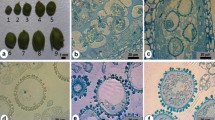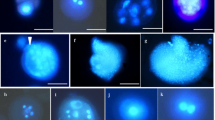Abstract
Androgenesis of wheat, rice and triticale was studied in isolated microspore culture. It is the first publication which studies microspore culture reaction of Hungarian rice varieties. The effect of different basic media, lack and absence of growth regulators in culture media were tested on important parameters of microspore culture. Direct embryogenesis was observed in microspore culture of wheat and triticale genotypes. In the case of rice, calli were induced in isolated rice microspore culture and haploid rice plantlets were regenerated via organogenesis.
In wheat, the effect of basic media (W14, A2, CHB3, P4-m) was compared and among them the W14, and A2 had a superior effect on embryo production and albino and green plantlet regeneration. In rice the C, CHB3 and MSm media were tested in microspore culture and the significantly highest numbers of calli were achieved by using C and CHB3 media depending on the genotypes. The lack of exogenous growth regulators was observed in isolated microspore culture of triticale and rice. Growth regulator-free medium had a positive effect on embryo production and plant regeneration of triticale genotypes, whereas in rice microspore culture multicellular structures did not continue their division without growth regulators from the third week of microspore culture. Developing of microspore-origin calli was maintained by supplement of 2,4-D and Kinetin combination in the microspore culture medium.
Similar content being viewed by others
References
Balatero C. H., Darvey N. L., Luckett D. J. 1995. Genetic analysis of anther-culture response in 6x triticale. Theor. Appl. Genet. 90: 279–284.
Bernard S. 1980. In vitro androgenesis in hexaploid triticale: determination of physical conditions increasing embryoid and green plant production. Z. Pflanzenzuchtg. 85: 308–321.
Blakeslee A., Belling J., Farnham M. E., Bergner A. D. 1922. A haploid mutant in Datura stramonium. Science 55: 646–647.
Charmet G., Bernard S. 1984. Diallel analysis of androgenetic plant production in hexaploid triticale (× Triticosecale, Wittmack). Theor. Appl. Genet. 69: 55–61.
Chen Y., Wang R. F., Tian W. Z. 1980. Studies on pollen culture in vitro and induction of plantlets in Oryza Sativa Subsp. Keng. Acta Genet. Sin. 7: 46–54 (in Chinese).
Cho M. S., Zapata F. J. 1988. Callus formation and plant regeneration in isolated pollen culture of rice (Oryza sativa L. cv. Taipei 309) Plant Sci. 58: 239–244.
Chu C. C., Hill R. D., Brule-Babel A. L. 1990. High frequency of pollen embryoid formation and plant regeneration in Triticum aestivum L. on monosaccharide containing media. Plant Sci. 66: 255–262
Datta S. K., Wenzel G. 1987. Isolated microspore derived plant formation via embryogenesis of Triticum aestivum L. Plant Sci. 48: 49–54.
Gland-Zwerger A., Javornik B., Bohanec B., Kreft I. 1994. Production of doubled haploid lines through anther culture in barley and triticale. In: Proceed. International Colloquium on Impact of Plant Biotechnology on Agriculture, ed. by Javornik B., Bohanec B. December 5–7, Rogla, Slovenia: 9–14.
Heszky L. E., Simon I. K. 1992. “Dáma”, the First Plant Variety of Biotechnology Origining from Hungary, Registered in 1992. Hung. Agric. Res. 1: 30–32.
Indrianto A., Barinova I., Touraev A., Heberle-Bors E. 2001. Tracking individual wheat microspores in vitro: identification of embryogenic microspores and body axis formation in the embryo. Planta 212: 163–174.
Jia W. J., Abe T., Futsuhara Y. 1987. Plant regeneration by pollen culture of rice. Rice Genet. Newsl. 4: 109–110.
Jia X., Zhuang J., Hu S., Ye C., Nie D. 1994. Establishment and application of the medium of anther culture of intergeneric hybrids of Triticum aestivum × Triticum agropyron. Sci. Agri. Sin. 27: 83–87.
Karsai I., Bedö Z., Hayes P. M. 1994. Effect of iduction medium pH and maltose consentration on in vitro androgenesis of hexaploid winter triticale and wheat. Plant Cell Tiss. Org. Cult. 39:49–53.
Kasha K. J., Maluszynski M. 2003. Production of doubled haploids in crop plants. An introduction. M. Maluszynski et al. (eds.): Doubled Haploid Production in Crop Plants. Kluwer Ac. Pub., pp.1–4.
Keller J. 1991. Influence of media conditioning on in vitro development in pollen suspensions of triticale. Biol. Zentrb. 110: 207–214.
Lentini, Z., Reyes P., Martinez C. P., Roca W. M. 1995. Androgenesis in highly recalcitrant rice genotypes with maltose and silver nitrate. Plant Sci. 110: 127–138.
Liu W., Zheng M. Y., Konzak C. F. 2002. Improving green plant production via isolated microspore culture in bread wheat (Triticum aestivum L). Plant Cell Rep. 20: 821–824.
Marciniak K., Banaszsak Z., Wedzony M. 1998. Effect of genotype, medium and sugar on triticale (× Triticosecale Wittmack) anther culture. Cer. Res. Comm. 26: 145–151.
Mejza S. J., Morgant V., Di Bona D. E., Wong J. R. 1993. Plant regeneration from isolated microspores of Triticum aestivum. Plant Cell Rep. 12: 149–153.
Monostori T., Lantos Cs., Mihály R., Pauk J. 2003. Induction of embryogenesis without exogenus hormone-supplement in barley microspore culture. Cer. Res. Comm. 31: 297–300.
Murashige T., Skoog F. 1962. A revised medium for rapid growth and bioassay with tobacco tissue culture. Physiol. Plant. 15: 473–497.
Ogava T., Fukuoka H., Okhawa Y. 1994. Induction of cell division of isolated pollen grains by sugar starvation in rice. Breed. Sci. 44: 75–77.
Oleszczuk S., Sowa S., Zimny J. 2004. Direct embryogenesis and green plant regeneration from isolated microspores of hexaploid triticale (× Triticosecale Wittmack) cv. Bogo. Plant Cell Rep. 22: 885–893.
Ouyang T. W., Hu J., Chuang C. C., Tseng C. C. 1973. Induction of pollen plants from anthers of Triticum aestivum L. cultured in vitro. Sci. Sin. 16: 79–95.
Ouyang J. W., Zhou S. M., Jia S. E. 1983. The response of anther culture to culture temperature in Triticum aestivum. Theor. Appl. Genet. 66: 101–109.
Pauk J., Manninen O., Mattila I., Salo Y., Puli S. 1991. Androgenesis in hexaploid spring wheat F2 population and their parents using a multiple step regeneration system. Plant Breeding 107: 18–27.
Pauk J., Poulimatka M., Lökös Tóth K., Monostori T. 2000. In vitro androgenesis of triticale in isolated microspore culture. Plant Cell Tiss. Org. Cult. 61: 221–229.
Puolimatka M., Laine S., Pauk J. 1996. Effect of ovary co-cultivation and culture medium on embryogenesis of directly isolated microspores of wheat. Cer. Res. Comm. 23: 393–400.
Purnhauser L., Gyulai G. 1993. Effect of copper on shoot and root regeneration in wheat, triticale, rape and tobacco tissue culture. Plant Cell Tiss. Org. Cult. 35: 131–139.
Raghavan V. 1988. Anther and pollen development in rice (Oryza sativa). Amer. J. Bot. 75: 183–196.
Raina S. K., Irfan S. T. 1998. High frequency embryogenesis and plantlet regeneration from isolated microspores of indica rice. Plant Cell Rep. 17: 957–962.
Simon-Kiss I. 2001. Six Decades of Rice Cultivation and Varietal Improvement in Hungary, Hungarian Agricult. Res. 10: 4–7.
Sun C. S., Wang C. C., Chu C. C. 1973. Cytological studies on the androgenesis of Triticale. Acta Bot. Sin. 15: 145–154.
Tuvesson I. K. D., Öhlund R. C. V. 1993. Plant regeneration through culture of isolated microspores of Triticum aestivum L. Plant Cell Tiss. Org. Cult. 34: 163–167.
Touraev A., Indrianto A., Wratschko I., Vicente O., Heberle Bors E. 1996. Efficient microspore embryogenesis in wheat (Triticum aestivum L.) induced by starvation at high temperatures. Sex. Plant Reprod. 9: 209–215.
Wang Y. Y., Sun C. S., Wang C. C., Chen N. F. 1973. The induction of pollen plantlets of Triticale and Capsicum annum from anther culture. Scientia Sin. 16: 147–151.
Xie J., Gao M., Cai Q., Cheng X., Shen Y., Liang Z. 1995. Improved isolated microspore culture efficiency in medium with maltose and optimized growth regulator combination in japonica rice (Oryza sativa). Plant Cell Tiss. Org. Cult. 42: 245–250.
Zhuang J. J., Xu J. 1983. Increasing differentiation frequencies in wheat pollen callus. In: Cell and tissue culture techniques for cereal crop improvement, ed. by Hu H, Vega M.R., Science, Beijing: 431–431.
Author information
Authors and Affiliations
Corresponding author
Additional information
HAS-SIU Research Group for Molecular Plant Breeding, Gödöll
Rights and permissions
About this article
Cite this article
Lantos, C., Jancsó, M. & Pauk, J. Microspore culture of small grain cereals. Acta Physiol Plant 27, 631–639 (2005). https://doi.org/10.1007/s11738-005-0067-6
Accepted:
Issue Date:
DOI: https://doi.org/10.1007/s11738-005-0067-6




